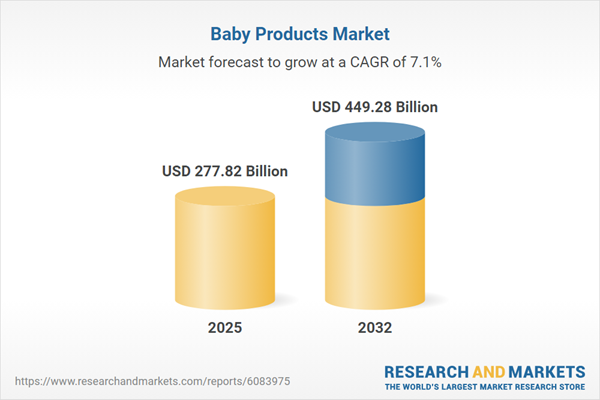Speak directly to the analyst to clarify any post sales queries you may have.
The baby products market is rapidly evolving as manufacturers respond to shifting consumer demands, advancing technologies, and tightening regulations. Senior decision-makers are seeking reliable intelligence to optimize portfolios and strengthen competitiveness in a sector where innovation and compliance are critical.
Market Snapshot: Baby Products Market Size, Growth, and Outlook
The Baby Products Market grew from USD 260.40 billion in 2024 to USD 277.82 billion in 2025. It is expected to continue growing at a CAGR of 7.05%, reaching USD 449.28 billion by 2032. Growth has been fueled by increased consumer focus on early childhood wellness and safety, a rise in dual-income households, accelerating urbanization, and robust product innovation. This trajectory reflects both expanding demand across varied end users and strong manufacturer response to regulatory, social, and environmental mandates.
Scope & Strategic Segmentation of the Baby Products Industry
This report provides in-depth segmentation and comprehensive market coverage, targeting the variables and dynamics that matter most to senior executives making strategic investments. Segmentation informs procurement, innovation, regulatory, and sales alignment initiatives across the value chain.
- Product Types: Apparel (including bottom-wear and top-wear), Food & Feeding Products, Furniture (dressers, high chairs), Personal Care (cosmetics, toiletries), Toys & Play Equipment, Travel & Gear
- Age Groups: Infants (0–1 year), Toddlers (1–3 years), Preschoolers (3–5 years)
- End Users: Households, Daycare Centers, Hospitals & Maternity Clinics
- Distribution Channels: Offline, Online
- Regional Coverage: Americas (including North America, Latin America), Europe, Middle East & Africa, Asia-Pacific. Includes key markets such as the United States, Canada, Brazil, United Kingdom, Germany, China, Japan, India, Australia, South Korea, South Africa, and others
- Technology Trends: IoT-enabled baby monitors, antimicrobial fabrics, digital supply chain platforms, modular/adaptive furniture, eco-certified personal care, and mobile-first ecommerce strategies
- Leading Companies Profiled: Abbott Laboratories, Artsana S.p.A., Beiersdorf AG, Britax Child Safety, CITTA by Lexicon, Cotton Babies, Dabur India, Danone, Dorel Industries, Essity AB, Himalaya Wellness, Johnson & Johnson, Kimberley-Clark, Koninlijke Philips, Mattel, Munchkin, Nestlé, Procter & Gamble, Sebapharma, The Honest Company, Unicharm, Unilever, among others
Key Takeaways for Senior Decision-Makers
- Heightened consumer expectations for safety and ease are influencing design and supply priorities across baby care categories.
- Digital and smart technologies, such as app-integrated monitors and predictive analytics, are shaping purchase criteria and enabling brands to offer data-driven value.
- Industry players are focusing on sustainability, transparent sourcing, and circular economy initiatives to meet regulatory and consumer responsibility goals.
- Customization and modularity in apparel, feeding systems, and furniture are increasingly critical for differentiating products and controlling upstream costs.
- Shifting demographics, notably urbanization and dual-income families, are increasing preference for compact, easy-to-use, and technology-augmented solutions.
- Institutional buyers’ bulk and contract ordering are influencing standardization trends and supply consolidation, with implications for pricing and compliance management.
Tariff Impact and Competitive Response
Recent United States tariff increases have raised supply chain and procurement costs for imported components such as performance fabrics and engineered plastics. Many organizations are now reevaluating supplier bases, exploring nearshoring, and renegotiating with domestic partners to mitigate risk and control expenses. This environment is encouraging supply chain diversification, private-label expansions, and greater margin management through innovative sourcing and bulk deal strategies, particularly among hospitals and daycare procurement teams.
Robust Methodology & Trusted Data Sources
This report synthesizes qualitative and quantitative approaches. In-depth interviews with industry leaders, supply chain managers, and retail buyers are paired with advanced data analysis from proprietary surveys and public trade sources. Rigorous triangulation and expert validation ensure reliability across all insights.
Why This Report Matters for Senior Decision-Makers
- Empowers executives with actionable intelligence to inform R&D, procurement, and market entry strategies based on real consumer behaviors and competitor moves.
- Clarifies regional growth drivers and digital transformation trends so leaders can tailor engagement, investment, and partnership strategies for each geography.
Conclusion
Grounded in rigorous analysis and direct industry input, this market research equips senior leaders to navigate complexity, align operations to future demand, and accelerate sustainable growth. Adaptation and innovation remain central to enduring success in the baby products market.
Table of Contents
3. Executive Summary
4. Market Overview
7. Cumulative Impact of Artificial Intelligence 2025
Companies Mentioned
The companies profiled in this Baby Products market report include:- Abbott Laboratories
- Artsana S.p.A.
- Beiersdorf AG
- Britax Child Safety, Inc.
- CITTA by Lexicon Lifestyle Pvt Ltd
- Cotton Babies, Inc.
- Dabur India Ltd
- Danone S.A.
- Dorel Industries
- Essity AB
- Fujian Hengan Group
- Himalay Wellness Company
- Honasa Consumer Ltd.
- Johnson & Johnson Services Inc.
- KAO Corporation
- Kimberly-Clark Corporation.
- Koninklijke Philips N.V.
- Mattel, Inc.
- Meiji Holdings Co., Ltd.
- Munchkin, Inc.
- Nestlé S.A.
- Prince Lionheart, Inc
- Procter & Gamble Company.
- S. C. Johnson & Son, Inc.
- Sebapharma GmbH & Co. KG
- The Honest Company
- Unicharm Corporation
- Unilever PLC
Table Information
| Report Attribute | Details |
|---|---|
| No. of Pages | 187 |
| Published | November 2025 |
| Forecast Period | 2025 - 2032 |
| Estimated Market Value ( USD | $ 277.82 Billion |
| Forecasted Market Value ( USD | $ 449.28 Billion |
| Compound Annual Growth Rate | 7.0% |
| Regions Covered | Global |
| No. of Companies Mentioned | 29 |








